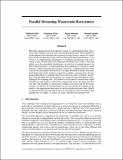Parallel Streaming Wasserstein Barycenters
Author(s)
Staib, Matthew; Claici, Sebastian; Solomon, Justin; Jegelka, Stefanie
DownloadPublished version (5.834Mb)
Terms of use
Metadata
Show full item recordAbstract
© 2017 Neural information processing systems foundation. All rights reserved. Efficiently aggregating data from different sources is a challenging problem, particularly when samples from each source are distributed differently. These differences can be inherent to the inference task or present for other reasons: sensors in a sensor network may be placed far apart, affecting their individual measurements. Conversely, it is computationally advantageous to split Bayesian inference tasks across subsets of data, but data need not be identically distributed across subsets. One principled way to fuse probability distributions is via the lens of optimal transport: the Wasserstein barycenter is a single distribution that summarizes a collection of input measures while respecting their geometry. However, computing the barycenter scales poorly and requires discretization of all input distributions and the barycenter itself. Improving on this situation, we present a scalable, communication-efficient, parallel algorithm for computing the Wasserstein barycenter of arbitrary distributions. Our algorithm can operate directly on continuous input distributions and is optimized for streaming data. Our method is even robust to nonstationary input distributions and produces a barycenter estimate that tracks the input measures over time. The algorithm is semi-discrete, needing to discretize only the barycenter estimate. To the best of our knowledge, we also provide the first bounds on the quality of the approximate barycenter as the discretization becomes finer. Finally, we demonstrate the practical effectiveness of our method, both in tracking moving distributions on a sphere, as well as in a large-scale Bayesian inference task.
Date issued
2017Department
Massachusetts Institute of Technology. Computer Science and Artificial Intelligence LaboratoryCitation
Staib, Matthew, Claici, Sebastian, Solomon, Justin and Jegelka, Stefanie. 2017. "Parallel Streaming Wasserstein Barycenters."
Version: Final published version